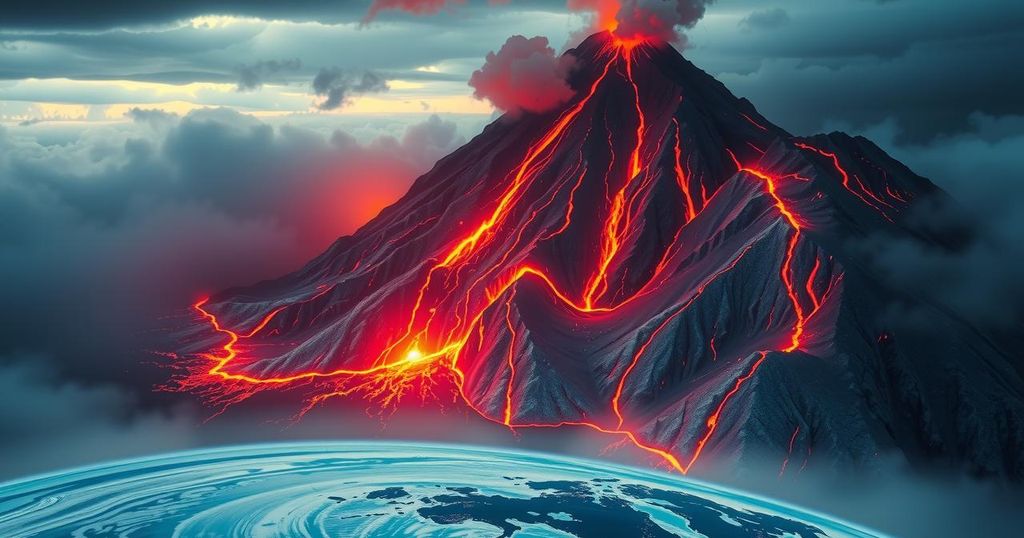Experts warn of the potential for a massive volcanic eruption this century, reminiscent of the 1815 Tambora event that caused widespread climate chaos. The current warming planet and population growth heighten vulnerabilities, prompting calls for preparedness strategies to address the potential impacts of such eruptions on global agriculture and economies. A one-in-six chance of a significant eruption accentuates the urgent need for thorough assessments and emergency planning.
The threat of an impending massive volcanic eruption poses significant global challenges, reminiscent of the catastrophic events following the eruption of Mount Tambora in 1815. This eruption cooled the planet, leading to widespread famine and illness, a harbinger for what might occur again due to natural geological cycles. Experts currently suggest there exists a one-in-six chance of a similar event happening within the current century, raising alarm over the unpreparedness of modern society in the face of potential climate disturbances.
In stark contrast to the world of 1815, today’s environment is markedly different due to climate change and population growth. According to Markus Stoffel, a climate professor at the University of Geneva, the next eruption could disrupt climate patterns on an unprecedented scale, as such events now occur within a warmer and more populated context. When volcanoes erupt, they emit a range of gases, predominantly sulfur dioxide. This gas can enter the stratosphere, where it contributes to the formation of aerosol particles that scatter sunlight, potentially reducing global temperatures.
Scientists have assessed the cooling impacts of historical eruptions, with Tambora being noted for lowering global temperatures by at least one degree Celsius. The implications of such cooling for modern agriculture and food security are dire, particularly in regions reliant on stable climates. Catastrophic outcomes could follow, including food shortages and devastating economic impacts, all inextricably linked to the unpredictable nature of volcanic activity. Understanding the complete implications of an eruption in an era of climate change is paramount for future preparedness.
Michael Rampino, a professor at New York University, encapsulates the precariousness of our current climate situation, stating, “It is a more unstable world now.” As climate-related conditions such as warmer ocean surfaces and altered rainfall patterns emerge, the effects of any significant eruption could be exacerbated. Furthermore, the opportunities for human preparation and mitigation strategies are critical, given that volcanoes cannot be predicted or prevented.
In summary, the convergence of geological processes and human-induced climate change presents an imminent challenge. Experts advocate for thorough assessments of potential scenarios, alongside establishing emergency plans aimed at mitigating the impacts of a forthcoming eruption. Clearly, the world remains ill-equipped to handle such a natural disaster, a reality that necessitates immediate attention and action.
The topic of volcanic eruptions and their impact on global climate revolves around significant historical events, particularly the eruption of Mount Tambora in 1815. This eruption is considered one of the most powerful in recorded history, causing devastating consequences that shaped climatic conditions for years. Modern scientists warn that the planet’s escalating temperatures and increased population density heighten the risks associated with future eruptions. Understanding these dynamics is crucial in preparing for potential catastrophes as the Earth’s geological processes continue to play a vital role in shaping our environment.
In conclusion, the possibility of a significant volcanic eruption this century presents critical challenges for humanity, particularly in regard to climate change. The historical precedents set by past eruptions illustrate the devastating consequences such events can yield. As the planet’s climate continues to fluctuate and worsen, it is imperative that preparedness strategies be developed to mitigate the impact of such disasters. Timely intervention and proactive measures will be essential to safeguard against future societal disruptions stemming from volcanic activity.
Original Source: www.cnn.com






